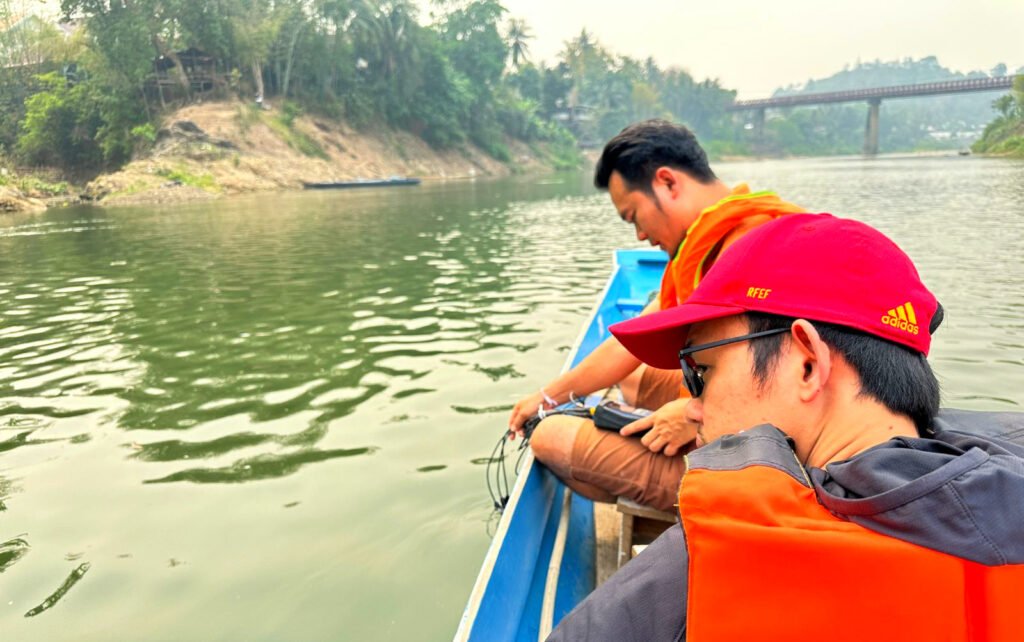The organisation has conducted a joint mission to investigate possible impacts of the spill of sulfuric acid from the road accident in Luang Prabang last week and learned there have been just initial impacts observed around the accident site so far
The Mekong River Commission has revealed the findings of its joint mission conducted on April 7, four days after the accident. A comprehensive site inspection by the joint mission team from the MRC Secretariate, Lao National Mekong Committee, the Department of Water Resources, the National Resources and Environmental Research Institute (NRERI) encompassed sampling and field measurements at multiple points along the canal, Nam Khan River and Mekong River to assess the spill’s impact, according to the MRC.
The organisation said field measurements revealed that while there were initial impacts observed at the incident site, including reduced dissolved oxygen levels and elevated sulfate concentrations, the water quality in the Nam Khan River and Mekong River remained unaffected. The MRC noted that the implementation of barriers from local authorities and neutralization measures effectively contained the spill’s effects, ensuring minimal environmental damage.
The regional organisation supporting Mekong regulation and diplomacy said the team will continue to monitor and assess water quality at the incident canal over the forthcoming days to ensure the protection of the environment and the public health of residents residing along the river.


l Locations of sampling points on April 7, 2024. Courtesy of MRC
In the afternoon of April 3, 2024, a truck carrying 30 tonnes of sulfuric acid had an accident in Ban Phou Xang Kham village in Luang Prabang, resulting in a significant spill in the canal nearby. According to the MRC, the accident occurred when the truck transporting sulfuric acid toppled over, leading to the leakage of approximately 50% of its contents. The accident site is located approximately 300 metres from the Nam Khan River and about 6 kilometres from the confluence of the Mekong River.
On April 4, local authorities erected barriers to prevent the acid-contaminated water from reaching the river. The distances from the confluence of the Mekong River to various points downstream, including Xayaburi Dam, Chiang Khan station (Thailand), and Stung Streng station (Cambodia), are approximately 105 km, 235 km, and 935 km, respectively.
The MRC Secretariat remained in close contact with the Lao Government authorities and officially informed the MRC member countries on April 5, it said. Recognizing the urgency of the situation due to the highly corrosive nature of sulfuric acid and its potential harm to living organisms, a team of experts along with provincial staff averted a potential environmental catastrophe through “swift containment and remediation efforts” over the weekend, the organisation noted, without elaborating how.
Thailand’s Office of National Water Resources has also confirmed the accident, saying the acid water travelled to Nam Khan through roadside drainage, and the water at the accident site took around 3 days to reach the Thai-Lao border at Kaeng Khut Khu in Chiang Khan district, Loei province.
The ONWR has been closely monitoring the water quality downstream and issued a warning to people living by the Mekong River twice and this will be undertaken until April 12. So far, the water quality at Kaeng Khut Khu has a pH measured at 8, suggesting that its acidity is normal, the secretary general said.
Indie • in-depth online news agency
to “bridge the gap” and “connect the dots” with critical and constructive minds on development and environmental policies in Thailand and the Mekong region; to deliver meaningful messages and create the big picture critical to public understanding and decision-making, thus truly being the public’s critical voice


